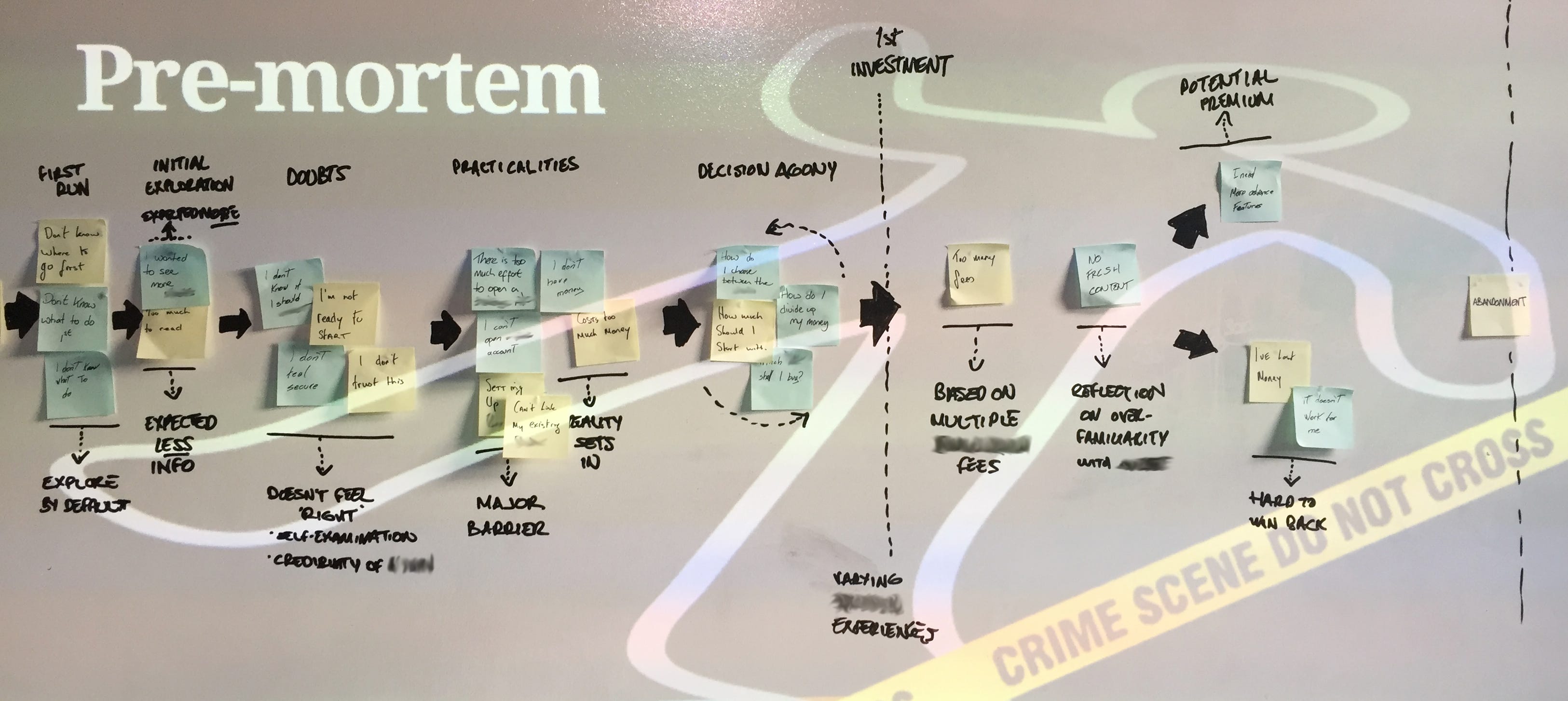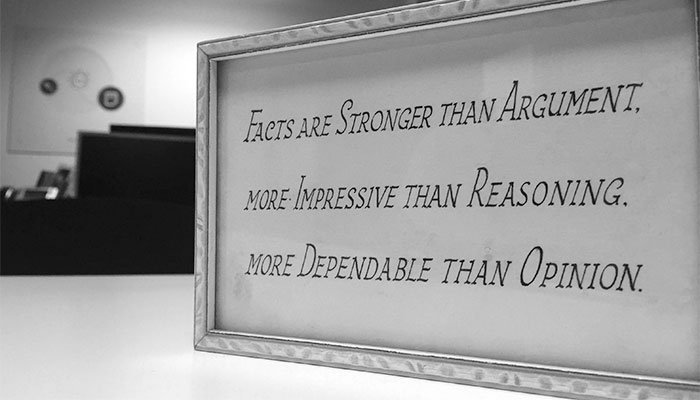“I have not failed. I’ve just found 10,000 ways that won’t work.” — Thomas A. Edison
One of the most effective ways to kick off a new initiative is to identify how it might go wrong. Similarly, when planning research goals and methodologies, awareness of potential weaknesses can help to establish immediate learning goals.
The Pre-Mortem is a well-established facilitation tool for use early in a project life cycle. As with a number of similar tools, the Pre-Mortem makes use of future projection to address the present.
If you are unfamiliar with it, the activity works like this: an assembled project or product team is asked to imagine a version of the future, a number of months down the line. The project/product/feature has shipped… and has been an abject failure. It wasn’t bought, it wasn’t adopted — whatever failure looks like for the issue in question. The Pre-Mortem then asks, simply: What caused this? Why did it go so wrong?
Eject the elephant from the room
Using a Pre-Mortem, a safe space is created for doubts, concerns or apprehensions to emerge and be expressed as a concern for the future, not as a gripe about the present, even though that’s what it very well may be.
In any team, there are often strongly-held points of view that can seep out throughout the course of not just a meeting, but an entire project. A Pre-Mortem actively invites such thoughts and feelings to be aired. These might otherwise fester, emerging only when there is a bump in the road — “we could have seen this coming!”.
Providing a forum that permits individuals to voice and record their concerns allows these strong opinions to be aired and treated with equity.
“When people have strong feelings about the topic, they often think of the meeting as a contest where their view — which they see as the correct one — should prevail. That leads them to try to convince others that their solution is the right one.”
– Roger Schwarz, author of ‘Smart Leaders, Smarter Teams’¹
While gathering doubts and concerns is a positive step in itself, these can be actively put to work as experiments to find (in Edison’s words) the things that won’t work.

Step-by-step
- Gather input on post-its . Ask participants to list 3 main factors that will have contributed to the project failing (online this can be done with tools such as Mural, Miro, or Google’s free Jamboard).
- Group the inputs — take time to find commonalities in the contributions, and collate them into groups.
- Identify themes —it may be helpful to think about these 3 categories²:
- feasibility: can we build, scale and support this — usually this will have a technical skew, but can apply to a broad range of resources.
- viability: will this be profitable or advantageous for the business.
- desirability: will customers find value in this.
4. Finally, devise small experiments³, capable of testing problems identified in each area. Be intentional about what you would need to learn, hear or see that will tell you your project will have difficulty succeeding. As a team, discuss the minimum amount of time, capital or resource required to test whether any of the issues represent credible threats to success.
Find what won’t work
If the issue is a real problem, how could you quickly test for it? Even modest pieces of secondary research, prototyping and competitive analysis can qualify, for example:
- Discover if anyone tried and failed to build something similar before. Have they themselves or others written about their experience? Stories of failure are often well documented.
- Put low-fidelity prototypes in front of potential customers or users. People testing low-fidelity prototypes are more likely to express negative reactions.
- Evaluating a market opportunity is a multi-faceted pursuit. But even this can start with a simple examination of existing, successful products which offer similar features, and a realistic assessment of what is required to compete – and where you fall short.
These are rudimentary activities for sure. However, before massive resources are put into motion, such small experiments that address particular elements of risk can challenge flawed beliefs that a product will thrive.
By leveraging the combined wisdom of the team, then gathering corroborating evidence from external objective signals, UX professionals can contribute to de-risking an initiative.
Mitigating risk
The ‘flipped’ nature of the Pre-Mortem is important in establishing a critical mindset. Confirmation bias is a natural human tendency. We look for validation of an idea, and find false positives. Testing for confirmation of weaknesses introduces critical thinking and can counter inherent biases.
“Optionality works on negative information, reducing the space of what we do by gaining knowledge of what does not work.”
– Barry O’Reilly, Optimize to be Wrong not Right
Innovation cannot be manufactured on demand. Success does not follow from throwing unlimited resources and capital at the ‘big idea’. Having more successful ideas is more likely to come from more ideas — small bets — against which small experiments can be run to identify failure points.
No time? No problem
Time more than all resources is limited. If this is the case for you or your team, and follow-up experiments are not an option, try this:
- Run through the Pre-Mortem exercise until you have a collated set of potential failure points.
- Discuss mitigations around the issues. Look for actions that can be taken now to alter that possible future. Work towards an actionable plan in the event of anything coming to fruition.
- Create a reference-able checklist, and review it at each retro or team meeting. If anything highlighted in the Pre-Mortem raising its head, go to your action plan.
Assuming that you have time for the Pre-Mortem itself, the very least you can get out of it is greater awareness. And that awareness can be codified.
Invest in failure
As you plan your stakeholder engagements and workshops, consider investing in a Pre-Mortem. It will typically take anything from 30–90 minutes, and it is capable of revealing that a project is partially or deeply flawed before it begins. For that reason alone it can prove invaluable to your team.
[1]: From ‘Eight Behaviors for Smarter Teams’ https://cdn.csu.edu.au/__data/assets/pdf_file/0008/917018/Eight-Behaviors-for-Smarter-Teams-2.pdf (PDF file)
[2]: From IDEO’s original ‘Three Lenses of Innovation’, introduced in the early 00s https://www.ideou.com/blogs/inspiration/how-to-prototype-a-new-business
[3]: Testing Business Ideas (Bland & Osterwalder, April 2020) is a fantastic resource for understanding how to run experiments against ideas. https://www.strategyzer.com/books/testing-business-ideas-david-j-bland


